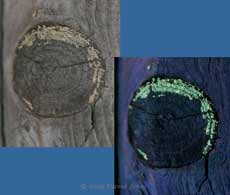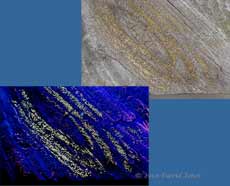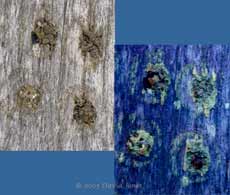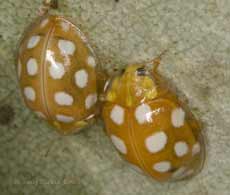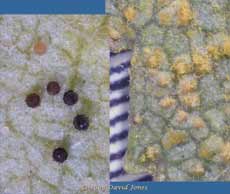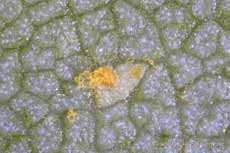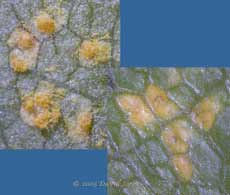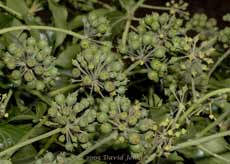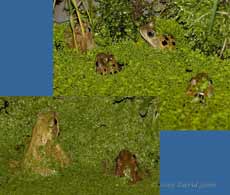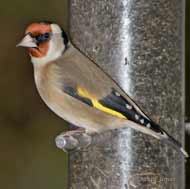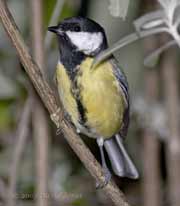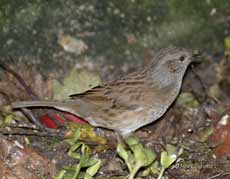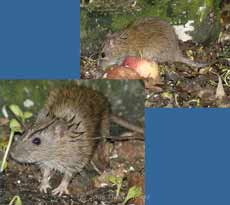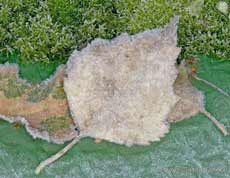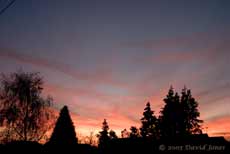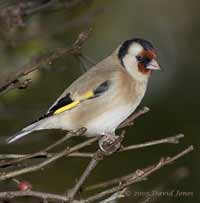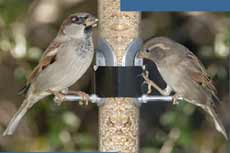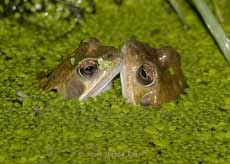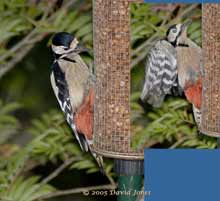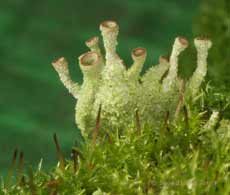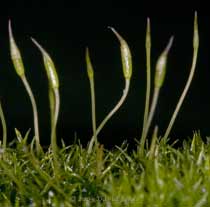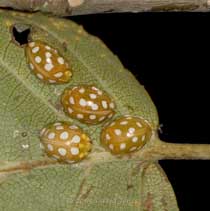Go to the last entry on this page .....Go to previous entry7 November - A dry day, apart for a bit of drizzle at the moment when I decided to go outside with my camera tonight. After a relatively mild night (min 8C) today it got up to 12C. I was looking for something on a shelf under my computer desk when I pulled out a UV lamp intended for use with security pens. As it was dark outside I decided to take it down the garden to see if I could find anything that is fluorescent.
This first one is a knot, The left-hand image was taken using flash, and the right-hand image was a long exposure under UV light.
Towards the end of the piece of timber there is a wood grain pattern which shows the position where a branch would have been growing out from the tree. In both examples, as well as a bright yellow/green fluorescence, there are also patches of almost magenta colouring.
This last pair of images shows the effect of pointing the UV light at the sealed nest holes of the solitary bees (Heriades truncorum). Like the grain patterns in the picture above, the material used to seal the holes fluoresces yellow-green, which perhaps makes sense as the bees use resin to seal the holes. You can also see how some of the grains of sand (that were added to the surface of the resin) are glowing red - fascinating. At some point I may spend more time investigating this. I pointed the UV lamp at many places, including the leaves of the Birch to see if the mildew would fluoresce - it did show up a little bit with that lamp, but nothing like the images above.
The Orange Ladybirds certainly didn't glow! They continue to be active on the tree, and I counted twelve in the short time I was by the tree. They are usually solitary, and just after I took this picture, this pair had gone their own ways.
9 November - Another sunny day, although some four degrees cooler than yesterday's high of 15C. I see that water levels in the south-east are still very low, so while these sunny days are nice, we do need to get some prolonged rain.
This pair of images were taken at the same scale, and the lines in the middle represent 0.25mm divisions.
This second image shows more clearly how the yellow fungus(?) seems to appear out of isolated areoles - these are the small areas between the network of fine veins that spread out across the leaf. While the surrounding areoles still contain green chlorophyl, the affected ones lose their green colour.
The right-hand image of this pair show how the upper leaf surface also shows a change when areoles are infected with the fungus. Although the yellow colour shows through, the fungus remains below the surface, only breaking out of the leaf on the underside.
The picture shows some of the furthest developed berries. To the right of the image you can see some of the 'failed' flowers that will drop off the plant soon. I was out for most of the day so I have little else to report from the garden. However, first thing this morning we had a visit from a Song Thrush, which tucked into the fast disappearing crop of Pyracantha berries. Also, over the last few days the local Sparrowhawk has started visiting more frequently again. Yesterday I saw it here twice.
11 November - It looks like being a second dull day in a row. Yesterday was a mild, dry day after a cold start, and when I wandered down the garden at 11pm it was still 14C! This morning it is very grey, and it is drizzling at 10.30am. The balmy conditions last night certainly had an effect on the frogs, and I counted at least thirty in sight in and around the two ponds. In contrast, in the gloomy light of this morning I can only see one. Despite what you read about frogs being in
hibernation by now, they are still very active here after dark, both in the pond and
wandering around the garden in search of worms etc. I've finally got started on next year's calendar. Good progress yesterday means that the basic layout is nearly complete and over the next few days I shall start to sort out the pictures. It will be available for downloading towards the end of December. 13 November - A dull, overcast day with just a few minutes of sunshine, and it's getting colder. The outside temperature reached only 9C today.
I've done very little this weekend, and today's pictures were all taken through our patio window (I must clean the glass!). The feeders are in constant use now with Goldfinches here more or less all the time.
It will be encouraging if the pair continue to visit regularly through the Winter. I must get on with jobs I need to do in and around the nestbox.
Down under the Hawthorn the Robin and Dunnock(s) continue to squabble over feeding rights. I was just in time to get this photograph before the Robin chased it off once again.
The Blackbird male made several visits this morning and now there are very few berries left on the Pyracantha now. The female hasn't been to them at all, preferring to feed on the ground.
Another visitor was somewhat less welcome this morning - a Brown Rat! We haven't seen one in the garden for a very long time, since I had to deal with one that tried to set up home here before I started the diaries. It only stayed for a minute or two, so hopefully was just passing through.
It was most obvious on the roof of the caravan shelter, and the neighbours would have been treated to me up a ladder in my dressing gown to grab a couple of shots. In this shot you can see how the shelter provided by these birch leaves was enough to prevent the frost extending underneath them.
The day was bright, with hazy sunshine not lifting the temperature much above 8C, and to complement the frosty start it ended with a fiery, but rather untidy sunset (with hardly a natural cloud to be seen amongst the vapour trails in our very busy airspace).
I didn't see any Goldfinches until nearly lunchtime, and although there is a picture of one in yesterday's entry I'm adding this one because it is one of the few I've managed to get away from the feeders. The male Blackbird didn't appear at all, and I saw his partner only once. I'm pleased to note that here was no sign of the rat today.
The male is in autumn plumage - its black bib with become more pronounced during the winter.
15 November - A dull and damp morning, but that cleared up later, and tonight the sky is starry with a full moon high above us. Following my entry about the Thistle seed feeder on the 1st today I bought a new feeder with eight perches and with narrow openings for access to the seeds inside. It will be interesting to watch the amount of seed that falls into the tray from this one. I now have my fingers crossed that the Goldfinch family doesn't desert us!
The cloudy start to the day meant that the temperature got up to over 10C in the daytime, and at 8pm it has just dipped below 8C. In the ponds there are only a few frogs in sight, and this pair presented the best pose, although I couldn't get really close to them.
No sign of the rat today.
16 November - A dry, bright day, although high, broken cloud meant that the sun couldn't warm us up, and it stayed at around 6-7C all day. I have spent a bit of time in the big birdbox today, starting to sort things out in the hope that we have birds move in for next Spring. There is no sign that it has been used for roosting (but this is normal). The Sparrowhawk came at least twice during the day, but didn't try very hard, leaving each time before I could grab my camera.
I walked out of our back door and disturbed this male Great Spotted Woodpecker. Fortunately, when I retreated back into the house it returned and stayed long enough for me to get the camera and dash upstairs to our bedroom. In the right-hand image, the bird is a bit out of focus, but it does show the banding on the underside of the wings. Once the wings are fully opened these appear as rows of white patches against a black backround.
While I was photographing the lichen at the beginning of the month I noticed, but didn't mention that the moss was sending up dark-tipped spikes, seen here in front of that strange looking lichen growth.
Today I took another look at them and, as the picture shows, the tops of the spikes swell as they develop into the Sporogonia. These grow from the female moss plants after sexual reproduction took place back in May. In the Sporogonia, spores are now developing, but it will take until next April for them to be ready for dispersal. On a couple of the heads you can see the cap, or operculum which protects the special, toothed structure (peristome) which will allow the wind to shake spores out of the sporongium during dry weather only.
I know that ladybirds group together to hibernate during the winter, but as the leaf could fall at any time, I guess that this is just an overnight roost. I find it amazing how they end up in a group like this when the tree still has so many leaves to choose from and there is quite a small population this year. I should point out that I also saw a couple of individuals elsewhere on the tree, so they didn't all come together! Click on the images to see larger versions - |
|
